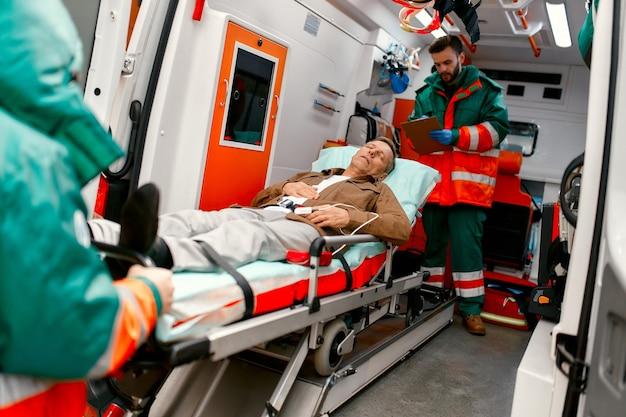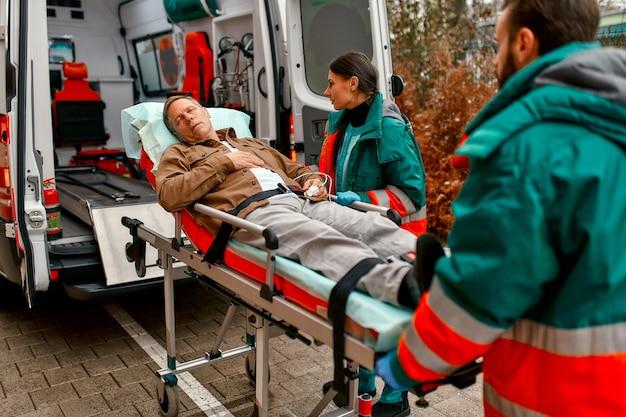Imagine a busy city street, sirens wailing in the distance, as a medical team rushes to respond to a critical emergency. In these moments, paramedics become the lifeline for individuals in distress, providing immediate medical care and transport. But have you ever wondered what tools they use to ensure the safe transfer of patients from one location to another?
In this blog post, we will delve into the world of paramedics and explore the equipment they employ to carry patients. From stretchers to specialized vehicles, we’ll uncover the essential gear that enables paramedics to transport individuals with utmost care and efficiency. Along the way, we’ll address commonly asked questions like how hospitals coordinate patient transfers and why communication between healthcare systems is crucial. So, let’s dive in and discover how paramedics save lives, one transport at a time.

What Do Paramedics Use to Carry Patients?
Emergency medical services (EMS) professionals are the unsung heroes who rush to the aid of those in need, providing life-saving care in critical moments. When it comes to carrying patients, paramedics have an arsenal of specialized equipment at their disposal. Let’s take a closer look at the essential tools they use to transport individuals to medical facilities.
1. The Stretcher: Where Comfort Meets Mobility
When you picture paramedics rushing to the scene of an accident, you likely envision a trusty stretcher by their side. These sturdy contraptions, also known as gurneys or litters, come in various shapes and sizes, specially designed to accommodate patients in different conditions.
2. The Classic Wheelchair: Rollin’ in Style
Not all patients require extensive mobility support. For those who can maintain a seated position, paramedics often opt for the trusty classic wheelchair. These convenient contraptions provide a secure and comfortable seat, making transportation a breeze.
3. Scoop Stretchers: A Perfect Fit for Immobilization
In situations where time is of the essence, paramedics turn to the ingenious scoop stretchers. These devices, resembling a literal scoop, allow quick and efficient extrication by sliding beneath the patient. With their ability to split in half, scoop stretchers conveniently cradle patients while minimizing movement.
4. The Evolving Power of Stair Chairs
Navigating stairs during an emergency can be quite the challenge. That’s where stair chairs enter the scene. These contraptions, equipped with tracks or wheels, enable paramedics to smoothly transport patients up or down staircases with minimal discomfort.
5. The Suspended Miracle: Air Ambulances
For situations that demand high-speed transport over long distances or travel across difficult terrain, paramedics rely on the extraordinary capability of air ambulances. These helicopters or fixed-wing aircraft are equipped with medical equipment and are staffed by highly skilled flight paramedics, ensuring critical care en route.
6. Beyond the Basics: Specialized Transport
Paramedics encounter diverse medical scenarios that require specialized equipment. From incubators for newborns to vacuum mattresses for spinal immobilization, they are equipped for anything that comes their way. The array of tools they carry demonstrates their commitment to providing optimal care, regardless of the situation.
When it comes to transporting patients, paramedics are prepared for every challenge. They use a myriad of tools, including stretchers, wheelchairs, scoop stretchers, stair chairs, air ambulances, and specialized equipment. Their dedication, expertise, and quick thinking help deliver patients safely to medical facilities, and we owe them a debt of gratitude for their remarkable service.
So, the next time you see paramedics in action, remember the incredible range of equipment they employ. They’re not just carrying patients; they’re carrying hope, compassion, and the promise of a brighter future.

FAQ: What do paramedics use to carry patients?
How do hospitals transport patients
When it comes to transporting patients between healthcare facilities, hospitals usually rely on specially equipped vehicles. These vehicles, known as ambulances, are designed to provide safe and comfortable transportation for patients in need. Whether it’s an emergency situation or a planned transfer, hospitals prioritize the well-being and proper care of patients during transportation.
Why do healthcare systems need to communicate with each other
Efficient communication between healthcare systems is crucial for ensuring seamless transitions during patient transfers. When a patient needs to be transported from one hospital to another, information exchange between the medical professionals involved is vital. This allows the receiving hospital to be fully prepared, with the necessary resources and medical history, to provide appropriate care upon the patient’s arrival.
How do you transfer a patient safely
To ensure the safe transfer of patients, healthcare providers follow established protocols and utilize specialized equipment. The process involves assessing the patient’s condition, stabilizing them if necessary, and securing them in a suitable transport device. This can include the use of stretchers, gurneys, or ambulance beds, depending on the patient’s needs and the level of care required during transport. The primary goal is to ensure the patient’s comfort and safety throughout the transfer process.
What do paramedics use to carry patients
Paramedics typically use stretchers or gurneys to transport patients. These devices are specifically designed to provide support and mobility while maintaining patient comfort. Stretchers are adjustable and can be elevated or lowered as needed. They often feature secure straps and handles that allow paramedics to transport patients smoothly and safely, minimizing any potential discomfort or risk during the journey.
Can you move a patient to a different hospital
Yes, patients can be moved to a different hospital when necessary. Sometimes, patients require specialized care or treatments that may not be available at their current facility. In such cases, healthcare providers can arrange for a transfer to a different hospital with the appropriate resources and expertise. This ensures that patients receive the highest quality of care and access to the specific medical interventions they require.
What is the thing ambulances use
Ambulances are equipped with a variety of essential medical equipment to support patients during transportation. Some of the common items include:
Stretcher or Gurney
Ambulances are designed to accommodate stretchers or gurneys that enable safe and convenient patient transportation. These devices are ergonomic, allowing paramedics to maintain stability while moving patients, ensuring their comfort throughout the journey.
Oxygen Delivery System
In situations where patients require oxygen support, ambulances are equipped with oxygen delivery systems. These systems include oxygen tanks, masks, and nasal cannulas, ensuring that patients receive the necessary oxygen supply during transportation.
Medical Supplies and Medications
Ambulances are stocked with an array of medical supplies and medications to address immediate medical needs. These supplies range from bandages and splints to life-saving medications, ensuring that healthcare professionals have the necessary resources to provide appropriate care en route to the hospital.
Communication Systems
To ensure effective communication between paramedics and the hospital, ambulances are equipped with communication systems such as radios or mobile devices. This allows paramedics to relay critical patient information and receive further guidance from medical professionals as required.
In conclusion, when it comes to transporting patients, healthcare providers prioritize safety, comfort, and effective communication. Ambulances serve as specialized vehicles equipped with stretchers, medical supplies, and communication systems to ensure the smooth transfer of patients between healthcare facilities. Efficient communication between healthcare systems is crucial to provide the best possible care and support for patients during their journey.
